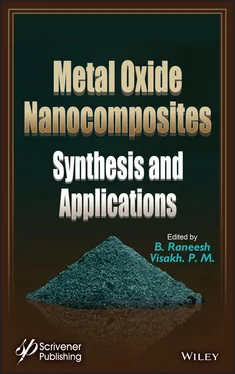Metal Oxide Nanocomposites
Здесь есть возможность читать онлайн «Metal Oxide Nanocomposites» — ознакомительный отрывок электронной книги совершенно бесплатно, а после прочтения отрывка купить полную версию. В некоторых случаях можно слушать аудио, скачать через торрент в формате fb2 и присутствует краткое содержание. Жанр: unrecognised, на английском языке. Описание произведения, (предисловие) а так же отзывы посетителей доступны на портале библиотеки ЛибКат.
- Название:Metal Oxide Nanocomposites
- Автор:
- Жанр:
- Год:неизвестен
- ISBN:нет данных
- Рейтинг книги:5 / 5. Голосов: 1
-
Избранное:Добавить в избранное
- Отзывы:
-
Ваша оценка:
- 100
- 1
- 2
- 3
- 4
- 5
Metal Oxide Nanocomposites: краткое содержание, описание и аннотация
Предлагаем к чтению аннотацию, описание, краткое содержание или предисловие (зависит от того, что написал сам автор книги «Metal Oxide Nanocomposites»). Если вы не нашли необходимую информацию о книге — напишите в комментариях, мы постараемся отыскать её.
Metal Oxide Nanocomposites — читать онлайн ознакомительный отрывок
Ниже представлен текст книги, разбитый по страницам. Система сохранения места последней прочитанной страницы, позволяет с удобством читать онлайн бесплатно книгу «Metal Oxide Nanocomposites», без необходимости каждый раз заново искать на чём Вы остановились. Поставьте закладку, и сможете в любой момент перейти на страницу, на которой закончили чтение.
Интервал:
Закладка:
Reinforcement can be of the square, triangular and round shapes, and the dimensions of all their sides are more or less equal [13]. The dispersion size in particulate composites is in microns range whereas volume concentration is greater than 28%. Their potential properties are based on the relative volumes of the metal and ceramic constituents [14]. Cermets are produced by impregnating the porous ceramic structure with a metallic matrix binder. Cermets can also be used as coating in a powder form where the powder is sprayed through a gas flame and fused to a base material. In a polymer composite, either the constituent matrix material or the fiber is a polymer. The polymer matrix composites (PMCs) compose of a polymer resin as the matrix material and fibers as the reinforcement medium [15]. The techniques to produce carbon fibers are relatively complex. Rayon, polyacrylonitrile (PAN), and pitch are used as organic precursor materials for producing carbon fibers. The processing techniques for composites are different than those for metals processing because composite materials involve two or more different materials [16]. Substantial changes in technology and its requirement in the past three to four decades have created many new needs and opportunities, which has fostered the need of advanced materials in associated manufacturing technology.
1.2 Graphene-Based Metal and Metal Oxide Nanocomposites
Carbon materials exist in all dimensionalities including zero-dimensional (0D) i.e. fullerenes, quantum dots, one-dimensional (1D) carbon nanotubes i.e. CNTs, two-dimensional (2D) i.e. graphene and three-dimensional (3D) i.e. graphite. Graphene is the appellation given to a two-dimensional sheet of sp2-hybridized carbon atoms with exceptionally high crystallinity and electronic property [17]. Lately, the nomenclature ‘‘graphene’’ was acclaimed by the commission of IUPAC as a substitute to the older name ‘‘graphite layers’’, for the reason that graphite is three-dimensionally (3D) stacked carbon structure. It has arose as a speedily growing wonder material in the field of material science due to its thinnest and the sturdiest structure [18]. In early 2004, it gained high significance after the studies presented by Geim’s group, who demonstrated the graphene sheets and stated their unparalleled electronic properties. Later, in 2010, Physics Nobel Prize for pioneering research highlighting the two-dimensional material graphene presented by the Royal Swedish Academy to pioneers namely, Andre Geim and Konstantin Novoselov [19]. The progress in research till date, on graphene is mainly focused on the chemical and physical route of synthesis of pristine graphene, its chemical modification, detailed characterization of its chemical and physical properties and functions, synthesis and characterization of graphene-based polymer composites and metal-oxide nanocomposites, aiming to exemplify the impression of graphene-based nanomaterials on the development of novel analytical developments and its applications. Despite the fact, Geim and coworkers also employed the use of mechanical exfoliation which led to many stimulating investigations on graphene and its electronic and mechanical properties [20]. Recently, a facile and green synthetic stratergy for the large scale production of graphene by means of ball-milling of graphite flakes with carbohydrates namely sucrose, Producing graphite through epitaxial growth under the effect of ultrahigh vacuum (UHV) annealing conditions of SiC surface has attracted many researchers and technologists for the semiconductor industry [21]. The practice of epitaxial growth of graphene layers on silicon carbide (SiC) substrates give an impression of being highly capable approach for the fabrication of electronic devices. Likewise, Berger and De Heer in the early days of graphene research provoked the usage of epitaxial graphene on SiC substrates [22].
Later, much research efforts have been dedicated to recognize the synthetic and mechanistic of graphene growth and detailed experiential studies to optimize the thickness of graphene layers. The merits of the Plasma enhanced chemical vapor deposition (PECVD) embraces the short deposition time around <5 min and a temperature of 650 °C for the growth of graphene layers (contrary to 1,000 °C for CVD) [23]. The aim of regulating pH with ammonia solution resulted in deprotonation of the carboxylic acid functionalities leading to the formation of well-dispersed graphene colloids [24]. Likewise, Athanasios and coworkers investigated the synthesis of reduced graphene oxide by engaging the use of sodium borohydride [25]. Apart from these, there are other chemical routes employing the use of hydroquinone [26] and strong alkaline stock solutions [27], thermal reduction and solvothermal methods have also been vastly studied. The thermal reduction of GO to form rGO, utilizes the thermal treatment (at high temperatures) to eradicate the oxide functional moieties from the surface of GO [28]. Sol–gel process is engaged for the synthesis of TiO 2-GO/rGO composites by the chemical reaction of titanium isopropoxide and GO/rGO sheets which ensued the surface hydroxyl groups on GO/rGO that necessitate nucleation sites [29]. The ss-DNA/Graphene nanocomposite offers a novel bio-graphene hybrid electrochemical platform for the biological determination of redox enzymes [30]. The covalent functionalization in graphene is commonly headed by a chemical oxidation of the graphite with the effect of strong acids and oxidants to acquire oxygen-rich functional moieties that assist as pioneers for the chelation of organic molecules. As detailed synthesis of GO outcomes in extremely functionalized oxygen surface moieties, thereby reaching the C/O fraction of 2:1 [31].
1.3 Carbon Nanotube–Metal Oxide Nanocomposites
Carbon nanotubes (CNTs) have received intense and growing interests since the first discovery in 1991 [32]. Structurally, CNTs are rolled-up graphene nanosheets, the ends of which are capped with a hemisphere of a buckyball [33, 34]. CNTs exist either as single-walled or multi-walled CNTs (SWCNTs or MWCNTs), and MWCNTs are composed of a series of concentric SWCNTs with an inter-tube distance of approximately 0.34 nm [35]. Depending on the atomic arrangement of the hexagonal rings (graphene structure) along the tubular surfaces, CNTs can be metallic and/or semiconducting. SWCNTs are generally regarded as a mixture of metallic and semiconducting material, while MWCNTs are metallic conductors [36]. CNTs offer tremendous exciting opportunities for physicists, chemists, biologists, engineers, and material scientists to develop fundamentally novel material systems, better serving the human being in an accelerating and sustainable fashion. Technically, CNTs can be hybridized with a wide spectrum of inorganic compounds such as oxides, nitrides, carbides, and ceramics, in which metal/metal oxides are currently the most widely exploited species due to their high modulus and strength especially at high temperatures. Consequently, CNT–metal/metal oxide NCs (CMNCs) are considered as promising candidates for many potential applications. CMNCs can be tailored to equip qualities such as lightweight (low density), low thermal expansion coefficient, and high thermal conductivity suitable for use in aerospace, automobile, and many other industries. For example, it is projected that applying CNT–Al and CNT–Mg NCs in automobiles would decrease CO 2emission by 50% per year, based on the report of Japan Automobile Manufacturers Association (JAMA). Prior to introducing the synthesis methods of CMNCs, it is informative to briefly retrieve the methods for preparation of CNTs first. Various approaches such as arc discharge [37], laser ablation [38], gas phase catalytic growth [39], and chemical vapor deposition (CVD) [40–42] have been commonly used to produce CNTs. To prepare CNTs for application in the NCs, the production of large quantities of CNTs is a prerequisite.
Читать дальшеИнтервал:
Закладка:
Похожие книги на «Metal Oxide Nanocomposites»
Представляем Вашему вниманию похожие книги на «Metal Oxide Nanocomposites» списком для выбора. Мы отобрали схожую по названию и смыслу литературу в надежде предоставить читателям больше вариантов отыскать новые, интересные, ещё непрочитанные произведения.
Обсуждение, отзывы о книге «Metal Oxide Nanocomposites» и просто собственные мнения читателей. Оставьте ваши комментарии, напишите, что Вы думаете о произведении, его смысле или главных героях. Укажите что конкретно понравилось, а что нет, и почему Вы так считаете.












